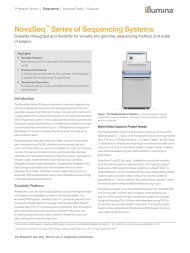Abstracts
ngsfinalprogram
ngsfinalprogram
You also want an ePaper? Increase the reach of your titles
YUMPU automatically turns print PDFs into web optimized ePapers that Google loves.
Poster <strong>Abstracts</strong><br />
utilize EDGE at an OCONUS DoD facility has<br />
already taken place, with successful processing<br />
of locally-generated data using a recently<br />
locally-installed MiSeq, and demonstrated<br />
reachback capability using CONUS support.<br />
n 103<br />
SUPERPHY: PREDICTIVE GENOMICS FOR<br />
THE PATHOGEN ESCHERICHIA COLI<br />
M. D. Whiteside 1 , C. R. Laing 1 , A. Manji 1 , J.<br />
Masih 1 , P. Kruczkiewicz 1 , E. N. Taboada 1 , V. P.<br />
J. Gannon 1<br />
1<br />
CANADA - Laboratory for Foodborne Zoonoses,<br />
Public Health Agency of Canada<br />
Introduction: Predictive genomics is the<br />
translation of raw genome sequence data into<br />
an assessment of the phenotypes exhibited by<br />
the organism. For bacterial pathogens, these<br />
phenotypes can range from environmental<br />
survivability, to the severity of human disease<br />
associated with them. Significant progress has<br />
been made in the development of generic tools<br />
for genomic analyses that are broadly applicable<br />
to all microorganisms; however, a fundamental<br />
missing component is the ability to<br />
analyze genomic data in the context of organism-specific<br />
phenotypic knowledge, which has<br />
been accumulated from decades of research<br />
and can provide a meaningful interpretation<br />
of genome sequence data. Implementation:<br />
In this study, we present SuperPhy, an online<br />
predictive genomics platform (http://lfz.corefacility.ca/superphy/)<br />
for Escherichia coli.<br />
The platform integrates the analyses tools and<br />
genome sequence data for all publicly available<br />
E. coli genomes and facilitates the upload<br />
of new genome sequences from users under<br />
public or private settings. SuperPhy provides<br />
real-time analyses of thousands of genome<br />
sequences with results that are understandable<br />
and useful to a wide community, including<br />
those in the fields of clinical medicine, epidemiology,<br />
ecology, and evolution. SuperPhy<br />
includes identification of: 1) virulence and<br />
antimicrobial resistance determinants 2) statistical<br />
associations between genotypes, biomarkers,<br />
geospatial distribution, host, source,<br />
and phylogenetic clade; 3) the identification<br />
of biomarkers for groups of genomes on the<br />
based presence / absence of specific genomic<br />
regions and single-nucleotide polymorphisms<br />
and 4) in silico Shiga-toxin subtype. Conclusions:<br />
SuperPhy is a predictive genomics platform<br />
that attempts to provide an essential link<br />
between the vast amounts of genome information<br />
currently being generated and phenotypic<br />
knowledge in an organism-specific context.<br />
n 104<br />
MOLECULAR SURVEILLANCE OF A.<br />
BAUMANNII IN A REGIONAL WASTE<br />
STABILISATION POND IN AUSTRALIA<br />
1, 2<br />
Maxim Sheludchenko, 2 Mohammad Katouli<br />
and 1 Helen Stratton<br />
1<br />
Smart Water Research Centre, Griffith University,<br />
Southport, Queensland and 2 Genecology<br />
Research Centre, University of the Sunshine<br />
Coast, Sippy Downs, Queensland, Australia<br />
A.baumannii is an increasingly important<br />
pathogen responsible for many nosocomial<br />
infections. Survival of these bacteria in the<br />
environment, especially in waste stabilization<br />
ponds (WSPs) have not been investigated before<br />
although some reports indicate isolation<br />
of these A. baumannii from filaments of active<br />
sludge of wastewaters and paleosol contaminated<br />
by waste leakage. Identification of A.<br />
baumannii from the environmental is normally<br />
done by growing samples on selective culture<br />
media but this requires the use of molecular<br />
techniques for confirmation. Furthermore,<br />
the ability of these bacteria to grow on some<br />
selective media may also cause misinterpretations<br />
of the data. In this study we report such<br />
an event and show that the use of molecular<br />
techniques especially 16S rRNA sequencing<br />
helped identification and surveillance of these<br />
bacteria in a WSP. Between October 2013 and<br />
September 2014 we surveyed the die off of a<br />
number of pathogens in the maturation pond of<br />
a WSP in a regional area of Australia. Samples<br />
cultivated on mCCDA agar containing selec-<br />
110<br />
ASM Conferences



